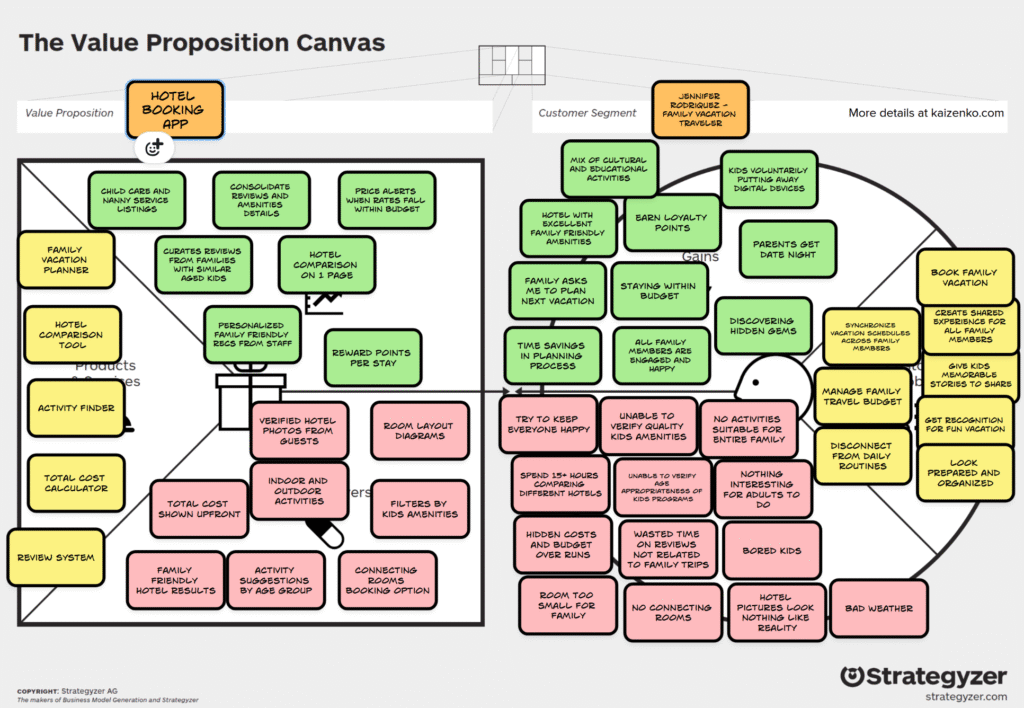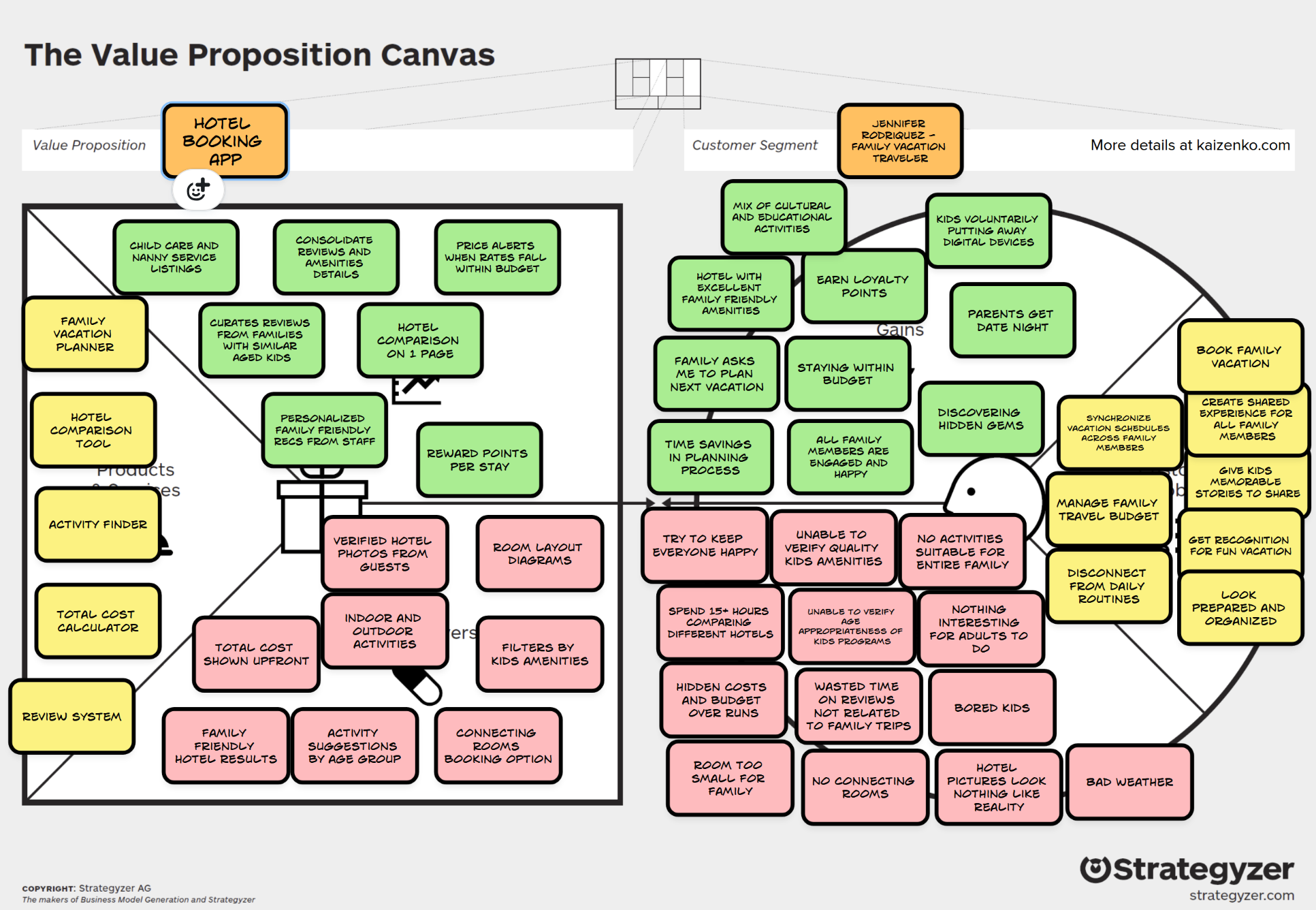The Value Proposition Canvas helps product teams make a critical strategic decision for their products: should you serve multiple customer types with one product, or focus deeply on a single customer profile? This customer segmentation choice often determines whether products achieve remarkable market success or deliver mediocre results across multiple segments.
Understanding how to leverage customer profiles within the Value Proposition Canvas framework drives better product-market fit and sustainable business growth.
Value Proposition Canvas Customer Profile Example
To demonstrate why distinct customer profiles drive product success, consider Jennifer Rodriguez, who want to make family vacation plans. Her customer profile differs dramatically from Sarah’s, the business traveler, illustrating why one-size-fits-all solutions satisfy no one customer segment effectively.
Jennifer’s Customer Profile: A Value Proposition Canvas Example Case Study

Customer Jobs (Functional):
- Manage family travel budget effectively across all vacation expenses
- Synchronize vacation schedules across family members during school breaks
- Book family vacation with appropriate accommodations and activities
Customer Jobs (Emotional):
- Disconnect from daily routines for quality family time
- Create shared experience for all family members that lasts beyond the vacation dates
Customer Jobs (Social):
- Give kids memorable stories to share with friends at school
- Look prepared and organized as the family vacation planner
- Get recognition for fun vacation from family and friends
Customer Pains in Vacation Planning:
- Try to keep everyone happy with conflicting family preferences
- Spend more than 15 hours comparing different hotels without clear family-focused criteria
- Hidden costs and budget overruns exceeding 10% destroying carefully planned finances
- Bored kids complaining during expensive vacation
- Unable to verify quality of kids amenities before booking
- Hotel pictures look nothing like reality creating disappointment upon arrival
- Room too small for family with insufficient space and privacy
- Kids getting lost in crowded tourist areas
- Unable to verify age appropriateness of kids programs before booking
- Wasted time on reviews not related to family trips during research
- No connecting rooms available
- Nothing interesting for adults to do while kids are occupied
- Food poisoning ruining vacation days
- Bad weather with no backup activity plans
Customer Gains in Vacation Planning:
- Time savings in planning process reducing research to under 10 hours
- Staying within budget without going over by more than 10%
- All family members engaged and happy during vacation
- Hotel with excellent family-friendly amenities that work for different age groups
- Mix of cultural and educational activities for different age groups
- Kids voluntarily putting away digital devices to engage with family
- Family asks me to plan next vacation recognizing planning success
- Discovering hidden gems that create unique family memories
- Parents get date night during vacation while kids are safely entertained
- Vacation photos showcasing successful family experience
- Hotel staff providing personalized service and local recommendations
Value Map for Jennifer’s Customer Profile: A Value Proposition Canvas Example Case Study

For Jennifer’s customer segment, a hotel booking service value proposition would emphasize:
Products and Services for Customer Jobs:
- Hotel booking platform
- Family vacation planner
- Hotel comparison tool
- Activity find
- Total cost calculator
- Verified review system
Pain Relievers for Customer Pains:
- Verified hotel photos from guests indoor and outdoor activities
- Connecting rooms booking option
- Room layout diagrams
- Filters by kids amenities
- Total cost shown upfront
- Family friendly hotel results
Gain Creators for Customer Gains:
- Price alerts when rates fall within budget
- Child care and nanny service listings
- Curates reviews from families with similar aged kids
- Personalized family friendly recs from staff
- Consolidate reviews and amenities details
- Activity suggestions by age group
- Hotel comparison on 1 page
- Reward points per stay
This customer profile example demonstrates why business travelers and family vacation planners require separate Customer Profiles and different value proposition strategies, even when using the same basic hotel booking service. Understanding these customer segmentation differences transforms good products into exceptional solutions that customers genuinely love and recommend.
From Customer Understanding to Strategic Prioritization

Just as with any customer profile analysis, we must prioritize which of Jennifer’s customer jobs, pains, and gains our hotel booking service should address strategically. Jennifer’s family vacation planning context involves complex decision-making, but focusing on where a hotel booking service creates maximum customer value drives product success. Remember, this is an iterative process where we test and validate both our understanding of the customer and our market assumptions to determine fit. In this post, it’s presented as a linear process for simplicity, and we are making assumptions instead of validating our hypothesis.
Jennifer’s Priority Customer Jobs for Hotel Booking Service:
- Book family accommodations for summer vacation (core functional job)
- Plan complete family vacation within budget constraints (hotel costs represent major budget component)
- Coordinate family travel dates and logistics (streamlined booking reduces complexity)
Jennifer’s Priority Customer Pains We Can Address:
- Time-consuming research across multiple booking platforms with inconsistent information
- Hidden costs and fees discovered late in the booking process creating budget stress
- Difficulty verifying family amenities and policies before booking confirmation
Jennifer’s Priority Customer Gains We Can Create:
- Time savings on family vacation planning and research efficiency
- Confidence in hotel choice for children’s entertainment and satisfaction
- Money savings within family budget through transparent pricing and package deals
This customer profile prioritization reveals a critical strategic challenge: serving Jennifer’s needs requires completely different product decisions than serving Sarah’s business travel needs.
How Customer Profile Differences Force Strategic Value Proposition Choices
When you attempt to build one product satisfying both a business traveler’s need for speed and a family planner’s need for comprehensive research, you create a mediocre solution that doesn’t excel at either customer job. Consider these conflicting customer requirements:
Business Travelers Customer Profile wants: Minimal booking steps, instant confirmation, business-focused filters, expense integration
Family Planners Customer Profile wants: Detailed comparisons, extensive information, family-focused research tools, budget optimization
A product trying to serve both customer segments might create a “quick booking” flow that’s too simple for family research needs, while adding family comparison features that slow down urgent business booking processes and reduce conversion rates.
Strategic Focus Creates Clear Product Direction
Choosing to focus on family vacation planners customer profile drives completely different product decisions than focusing on business travelers:
Information richness over booking speed: Detailed comparison charts and family amenity breakdowns
Research-supporting features: Save favorites, comparison tables, review aggregation systems
Desktop-optimized user experience: Supporting evening research sessions with spreadsheet comparisons
Transparency tools development: Upfront total cost calculators and comprehensive fee breakdowns
Value positioning strategy: Emphasizing savings and family value over booking convenience
Why Strategic Focus Creates Competitive Advantage
Companies that choose one Customer Profile and execute brilliantly often capture significant market share in that segment, then expand to serve other customer segments from a position of strength. Consider successful examples:
- Slack focused on tech teams customer profile first, then expanded to other industry segments
- Zoom prioritized business users customer profile before adding consumer features
- Airbnb initially served budget-conscious travelers customer profile before adding luxury options
When you’re exceptional for business travelers, other corporate users recommend your product through word-of-mouth marketing. When you’re perfect for family planners, other parents share your service within their social networks. Being “pretty good” for both customer segments means neither group becomes passionate advocates for sustainable growth.
When Multiple Customer Profiles Make Sense
You might serve multiple Customer Profiles when:
- Your company has sufficient resources to support multiple product teams and development tracks
- The customer segments share significant overlap in their core jobs, pains, and gains (less common than teams assume)
- You can create clearly differentiated experiences (like separate apps or distinct user flows) rather than one compromised solution
But for most product teams, especially those building new products or features, the strategic choice to focus deeply on one Customer Profile creates better products, clearer marketing messages, and stronger market positioning than attempting to serve multiple customer segments adequately.
The Strategic Power of Customer Profile Focus
The Value Proposition Canvas becomes most powerful when combined with strategic customer profile focus. Rather than trying to be everything to everyone, successful products typically:
- Choose one primary customer profile and serve them exceptionally well through focused value creation
- Build passionate advocates within that focused customer segment through superior problem-solving
- Achieve strong product-market fit before expanding to adjacent customer segments
- Use focused success as a foundation for sustainable growth into new market opportunities
This focused customer profile approach doesn’t limit your eventual market size; it provides the foundation for sustainable growth by creating products that customers genuinely love and recommend to others within their networks.
Companies achieving remarkable success understand that serving one customer segment brilliantly creates more value than serving multiple segments adequately. When you have passionate customers in one segment, expansion becomes a strategic choice rather than a necessity for business survival.
By strategically focusing on a customer profile when using the Value Proposition Canvas, you create the foundation for products that don’t just meet market needs but create new markets and build loyal customer communities, driving sustainable business growth and competitive advantage.
Resources for Further Learning
Value Proposition Canvas Tools:
- Strategyzer – Official home of the Value Proposition Canvas and Business Model Canvas by Alexander Osterwalder
Complementary Product Development Frameworks:
- Value Proposition Canvas: Essential Guide for Product-Market Fit – Learn VPC essentials
- How to Create Personas That Drive Product Decisions – Learn to build research-based customer personas using the Persona Canvas
- Jobs to Be Done Framework: The Product Manager’s Guide – Discover customer motivations and switching triggers that drive product success
- Value Proposition Canvas: Essential Guide for Product-Market Fit – Learn how to transform customer insights into successful products by creating perfect alignment between customer needs and product offerings.
Professional Development:
- Building Innovative Products Workshop – Four-day immersive training covering Value Proposition Canvas, customer research, and product strategy
- Business Model Canvas Workshop – Deep dive into complete business model design including value propositions and revenue models
- Advanced Certified Scrum Product Owner (A-CSPO) – Advanced certification covering Customer Profile Map development alongside customer research and stakeholder management



